2022 TOYOTA SIENNA HYBRID towing
[x] Cancel search: towingPage 3 of 600
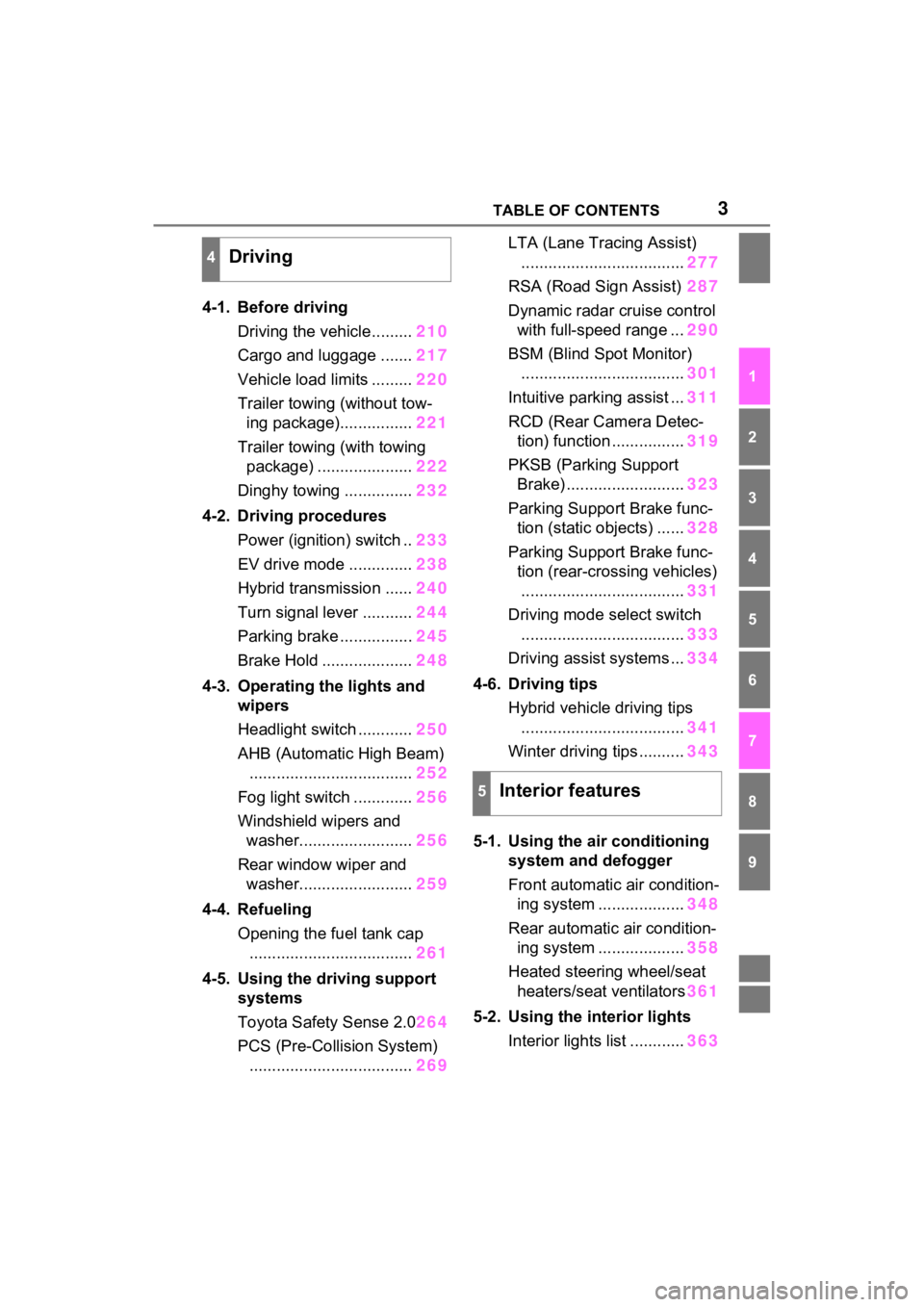
3TABLE OF CONTENTS
1
2
3
4
5
6
7
8
9
4-1. Before drivingDriving the vehicle......... 210
Cargo and luggage ....... 217
Vehicle load limits ......... 220
Trailer towing (without tow- ing package)................ 221
Trailer towing (with towing package) ..................... 222
Dinghy towing ............... 232
4-2. Driving procedures Power (ignition) switch .. 233
EV drive mode .............. 238
Hybrid transmission ...... 240
Turn signal lever ........... 244
Parking brake ................ 245
Brake Hold .................... 248
4-3. Operating the lights and wipers
Headlight switch ............ 250
AHB (Automatic High Beam) .................................... 252
Fog light switch ............. 256
Windshield wipers and washer......................... 256
Rear window wiper and washer......................... 259
4-4. Refueling Opening the fuel tank cap.................................... 261
4-5. Using the driving support
systems
Toyota Safety Sense 2.0 264
PCS (Pre-Collision System) .................................... 269LTA (Lane Tracing Assist)
.................................... 277
RSA (Road Sign Assist) 287
Dynamic radar cruise control with full-speed range ... 290
BSM (Blind Spot Monitor) .................................... 301
Intuitive parking assist ... 311
RCD (Rear Camera Detec- tion) function ................ 319
PKSB (Parking Support Brake) .......................... 323
Parking Support Brake func- tion (static objects) ...... 328
Parking Support Brake func- tion (rear-crossing vehicles).................................... 331
Driving mode s elect switch
.................................... 333
Driving assist systems ... 334
4-6. Driving tips Hybrid vehicle driving tips.................................... 341
Winter driving tips .......... 343
5-1. Using the ai r conditioning
system and defogger
Front automatic air condition- ing system ................... 348
Re ar automatic air condition-
i n
g system ................... 358
Heated steering wheel/seat heaters/seat ventilators 361
5-2. Using the interior lights Interior lights list ............ 363
4Driving
5Interior features
Page 21 of 600
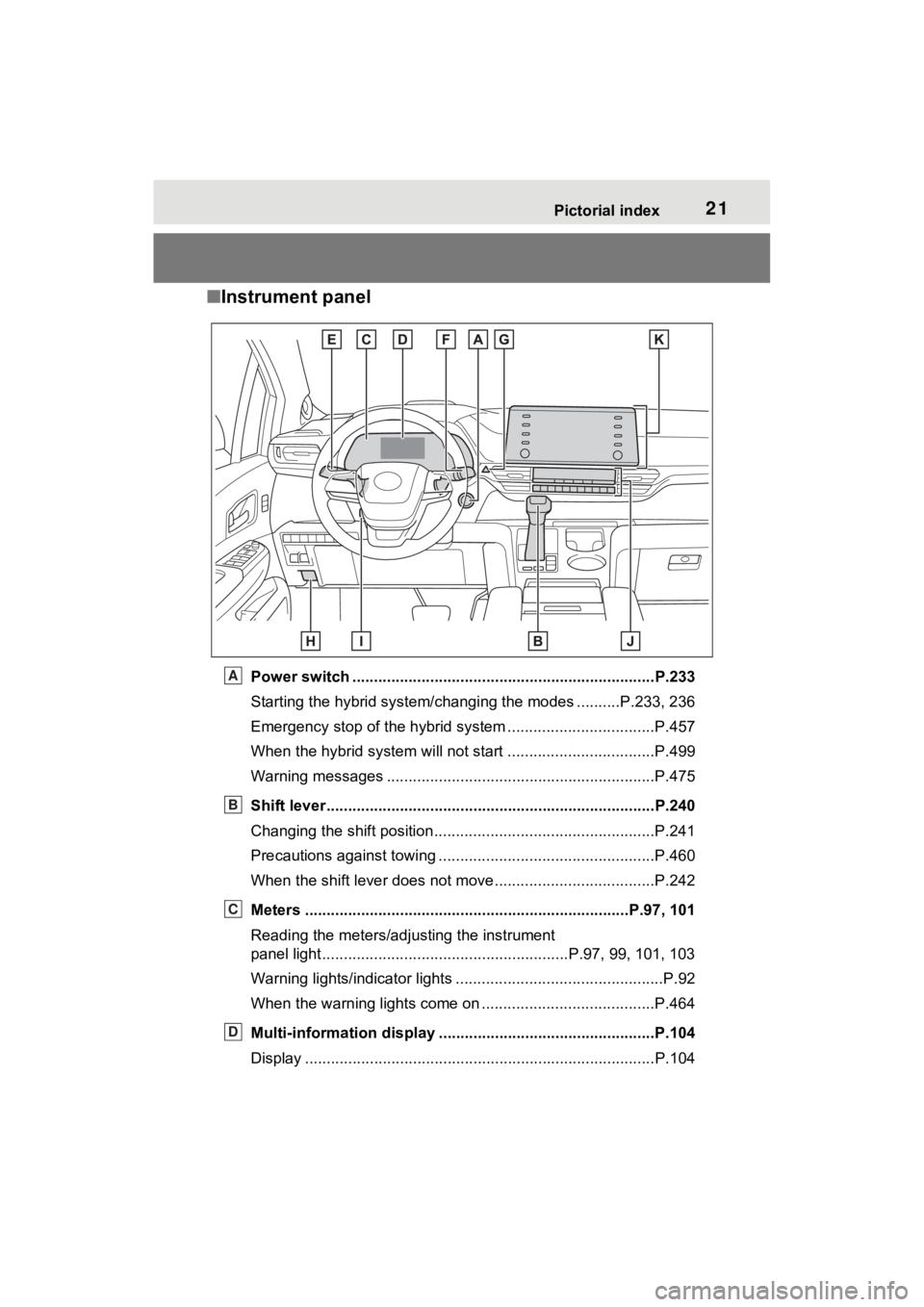
21Pictorial index
■Instrument panel
Power switch ................................................... ...................P.233
Starting the hybrid system/chan ging the modes ..........P.233, 236
Emergency stop of the hybrid system ............................ ......P.457
When the hybrid system will not start .......................... ........P.499
Warning messages ..............................................................P.475
Shift lever.................................................... ........................P.240
Changing the shift position.................................... ...............P.241
Precautions against towing ..................................................P.460
When the shift lever does not move............................. ........P.242
Meters ......................................................... ..................P.97, 101
Reading the meters/adjusting the instrument
panel light.................................................... .....P.97, 99, 101, 103
Warning lights/indicator lights ................................ ................P.92
When the warning lights come on ................................ ........P.464
Multi-information display . .................................................P.104
Display .................................................................................P.104A
B
C
D
Page 38 of 600

381-1. For safe use
3Push into until a click
sound is heard.
Plate “B”
Buckle “B”
1 To release , press the
release button on .
Plate “B”
Buckle “B”
2 To release , insert the key
( P.128) or into the hole
on .
Retract the belt slowly when releas- ing and stowing the seat belt.
Plate “A”
Plate “B”
Buckle “A”
3 Insert the seat belt plates (
and ) into the holder on
the roof as shown.
Plate “A”
Plate “B”
■Emergency locking retractor
(ELR)
The retractor will lock the belt during
a sudden stop or on impact. It may
also lock if you lean forward too
quickly. A slow, easy motion will
allow the belt to extend so that you
can move around fully.
Releasing and stowing
the seat belt (for the third
center seat)
AB
A
B
A
B
A
B
A
B
C
A
B
C
A
B
A
B
Page 67 of 600
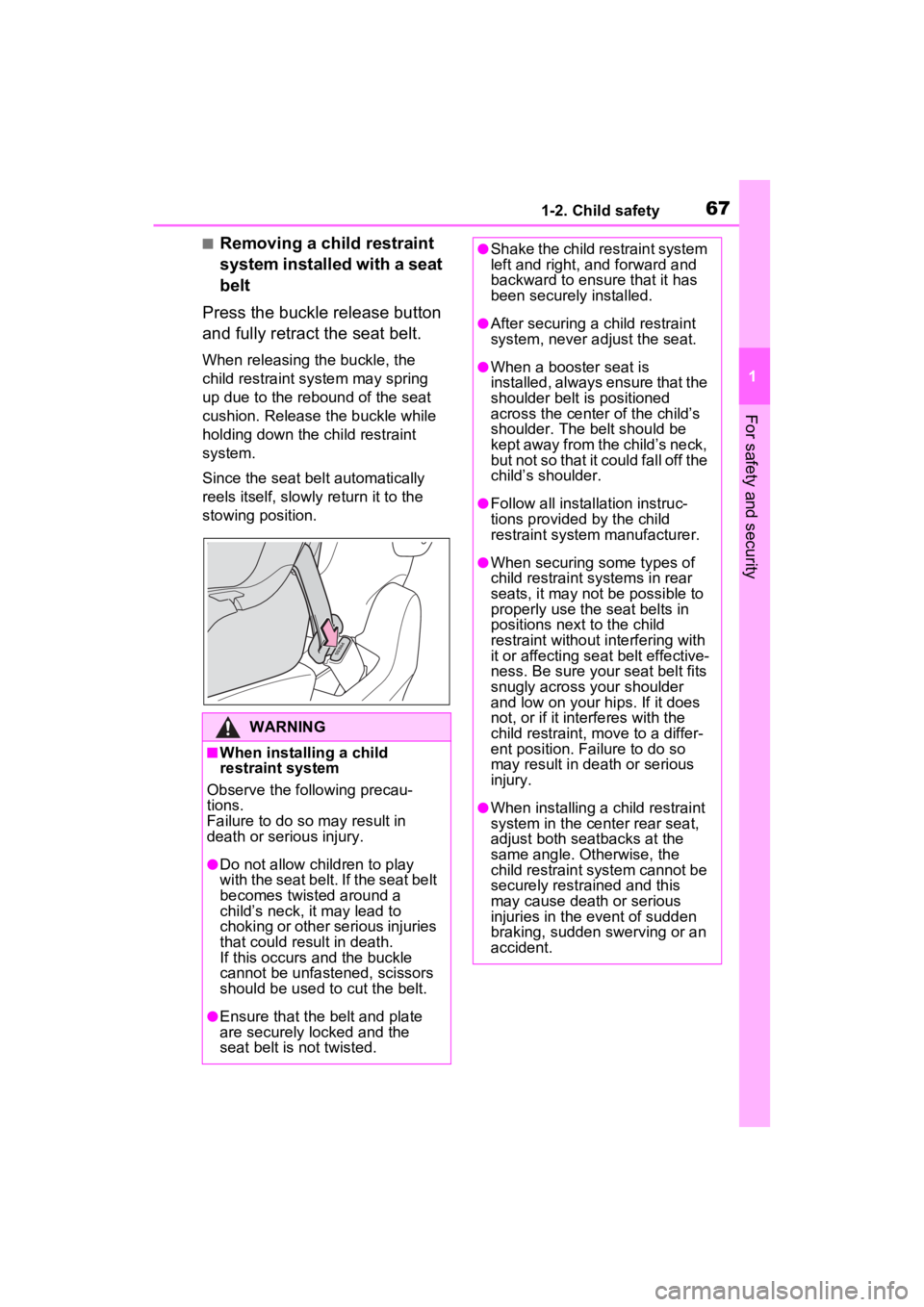
671-2. Child safety
1
For safety and security
■Removing a child restraint
system installed with a seat
belt
Press the buckle release button
and fully retract the seat belt.
When releasing the buckle, the
child restraint system may spring
up due to the rebound of the seat
cushion. Release the buckle while
holding down the child restraint
system.
Since the seat belt automatically
reels itself, slowly return it to the
stowing position.
WARNING
■When installing a child
restraint system
Observe the following precau-
tions.
Failure to do so m ay result in
death or serious injury.
●Do not allow children to play
with the seat belt. If the seat belt
becomes twisted around a
child’s neck, it may lead to
choking or other serious injuries
that could result in death.
If this occurs and the buckle
cannot be unfastened, scissors
should be used to cut the belt.
●Ensure that the belt and plate
are securely locked and the
seat belt is not twisted.
●Shake the child restraint system
left and right, and forward and
backward to ensure that it has
been securely installed.
●After securing a child restraint
system, never adjust the seat.
●When a booster seat is
installed, always ensure that the
shoulder belt is positioned
across the center of the child’s
shoulder. The belt should be
kept away from the child’s neck,
but not so that it could fall off the
child’s shoulder.
●Follow all installation instruc-
tions provided by the child
restraint system manufacturer.
●When securing some types of
child restraint systems in rear
seats, it may not be possible to
properly use the seat belts in
positions next to the child
restraint without interfering with
it or affecting s eat belt effective-
ness. Be sure your seat belt fits
snugly across your shoulder
and low on your hips. If it does
not, or if it interferes with the
child restraint, move to a differ-
ent position. Fa ilure to do so
may result in death or serious
injury.
●When installing a child restraint
system in the ce nter rear seat,
adjust both seatbacks at the
same angle. Otherwise, the
child restraint system cannot be
securely restrained and this
may cause death or serious
injuries in the event of sudden
braking, sudden swerving or an
accident.
Page 78 of 600
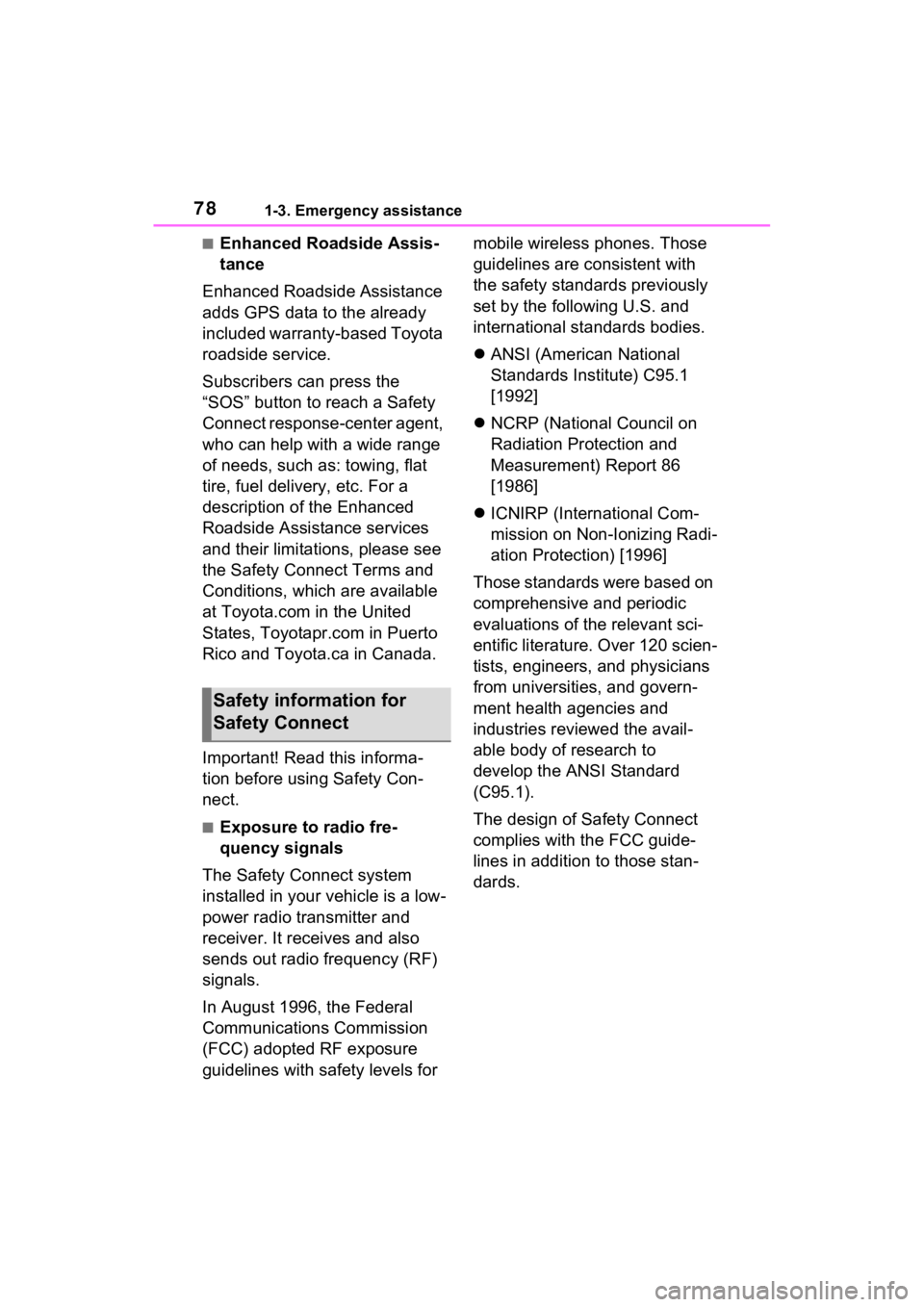
781-3. Emergency assistance
■Enhanced Roadside Assis-
tance
Enhanced Roadside Assistance
adds GPS data to the already
included warranty-based Toyota
roadside service.
Subscribers can press the
“SOS” button to reach a Safety
Connect response-center agent,
who can help with a wide range
of needs, such as: towing, flat
tire, fuel delivery, etc. For a
description of the Enhanced
Roadside Assistance services
and their limitations, please see
the Safety Connect Terms and
Conditions, which are available
at Toyota.com in the United
States, Toyotapr.com in Puerto
Rico and Toyota.ca in Canada.
Important! Read this informa-
tion before using Safety Con-
nect.
■Exposure to radio fre-
quency signals
The Safety Connect system
installed in your vehicle is a low-
power radio transmitter and
receiver. It receives and also
sends out radio frequency (RF)
signals.
In August 1996, the Federal
Communications Commission
(FCC) adopted RF exposure
guidelines with safety levels for mobile wireless phones. Those
guidelines are consistent with
the safety standards previously
set by the following U.S. and
international standards bodies.
ANSI (American National
Standards Institute) C95.1
[1992]
NCRP (National Council on
Radiation Protection and
Measurement) Report 86
[1986]
ICNIRP (International Com-
mission on Non-Ionizing Radi-
ation Protection) [1996]
Those standards were based on
comprehensive and periodic
evaluations of the relevant sci-
entific literature. Over 120 scien-
tists, engineers, and physicians
from universities, and govern-
ment health agencies and
industries reviewed the avail-
able body of research to
develop the ANSI Standard
(C95.1).
The design of Safety Connect
complies with the FCC guide-
lines in addition to those stan-
dards.
Safety information for
Safety Connect
Page 85 of 600
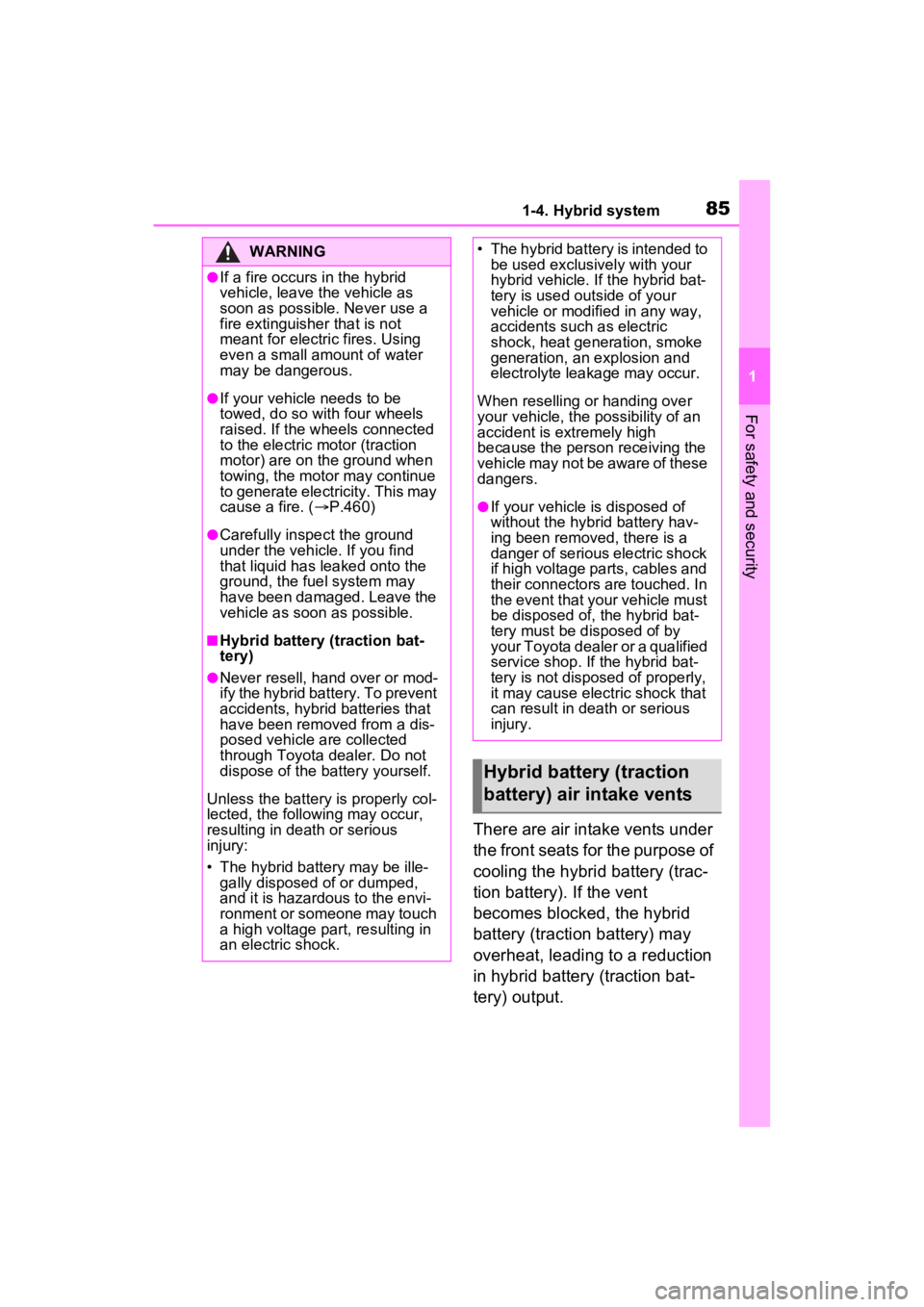
851-4. Hybrid system
1
For safety and security
There are air intake vents under
the front seats for the purpose of
cooling the hybrid battery (trac-
tion battery). If the vent
becomes blocked, the hybrid
battery (traction battery) may
overheat, leading to a reduction
in hybrid battery (traction bat-
tery) output.
WARNING
●If a fire occurs in the hybrid
vehicle, leave the vehicle as
soon as possible. Never use a
fire extinguisher that is not
meant for electric fires. Using
even a small amount of water
may be dangerous.
●If your vehicle needs to be
towed, do so with four wheels
raised. If the wheels connected
to the electric motor (traction
motor) are on the ground when
towing, the motor may continue
to generate electricity. This may
cause a fire. ( P.460)
●Carefully inspect the ground
under the vehicle. If you find
that liquid has leaked onto the
ground, the fuel system may
have been damaged. Leave the
vehicle as soon as possible.
■Hybrid battery (traction bat-
tery)
●Never resell, hand over or mod-
ify the hybrid battery. To prevent
accidents, hybrid batteries that
have been removed from a dis-
posed vehicle are collected
through Toyota dealer. Do not
dispose of the battery yourself.
Unless the battery is properly col-
lected, the follo wing may occur,
resulting in dea th or serious
injury:
• The hybrid battery may be ille- gally disposed of or dumped,
and it is hazardous to the envi-
ronment or someone may touch
a high voltage part, resulting in
an electric shock.
• The hybrid battery is intended to be used exclusively with your
hybrid vehicle. If the hybrid bat-
tery is used out side of your
vehicle or modified in any way,
accidents such as electric
shock, heat generation, smoke
generation, an explosion and
electrolyte leakage may occur.
When reselling or handing over
your vehicle, the possibility of an
accident is extremely high
because the person receiving the
vehicle may not be aware of these
dangers.
●If your vehicle is disposed of
without the hybrid battery hav-
ing been removed, there is a
danger of serious electric shock
if high voltage parts, cables and
their connectors are touched. In
the event that your vehicle must
be disposed of, the hybrid bat-
tery must be disposed of by
your Toyota dealer or a qualified
service shop. If the hybrid bat-
tery is not disposed of properly,
it may cause electric shock that
can result in dea th or serious
injury.
Hybrid battery (traction
battery) air intake vents
Page 175 of 600
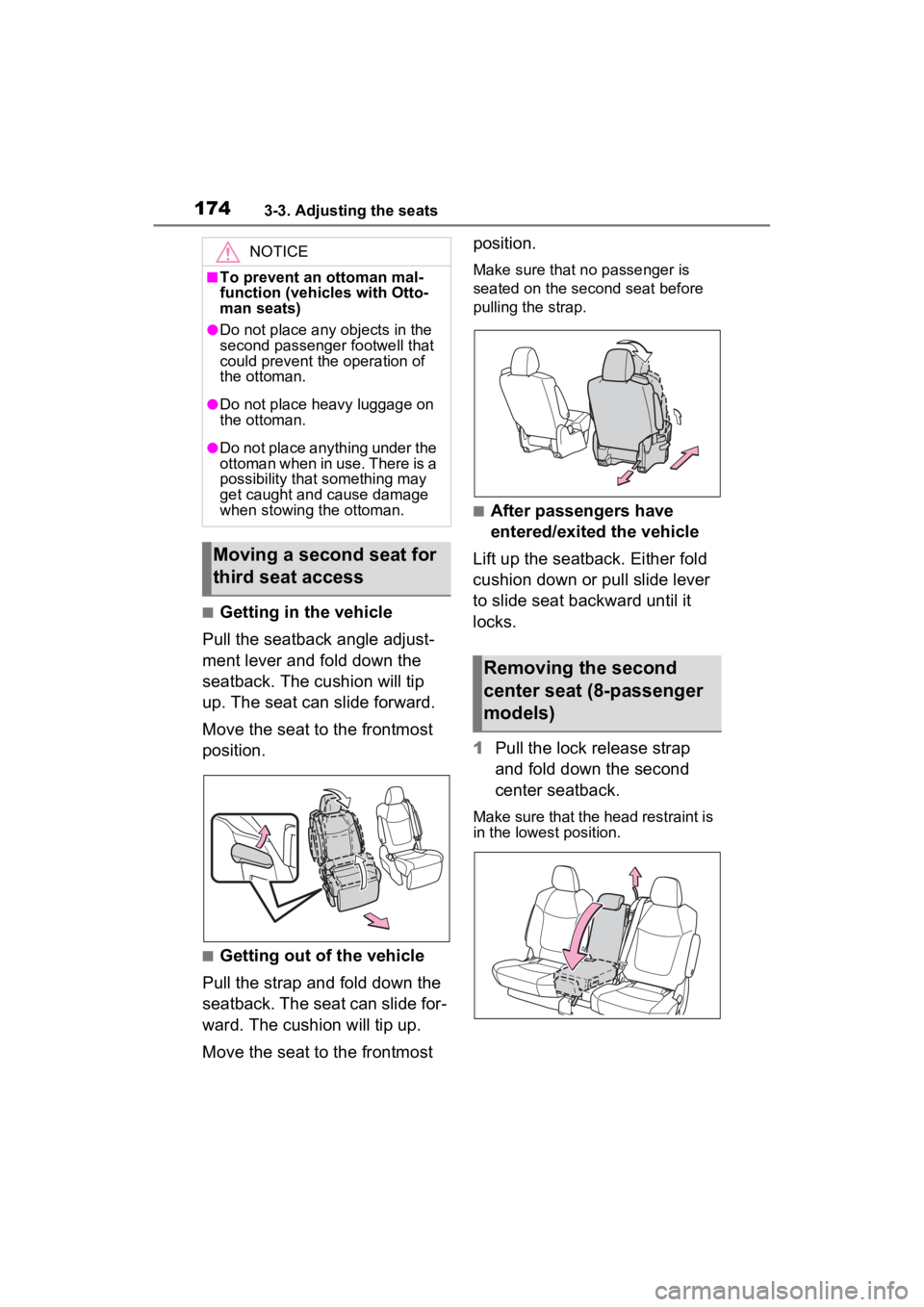
1743-3. Adjusting the seats
■Getting in the vehicle
Pull the seatback angle adjust-
ment lever and fold down the
seatback. The cushion will tip
up. The seat can slide forward.
Move the seat to the frontmost
position.
■Getting out of the vehicle
Pull the strap and fold down the
seatback. The seat can slide for-
ward. The cushion will tip up.
Move the seat to the frontmost position.
Make sure that no passenger is
seated on the second seat before
pulling the strap.
■After passengers have
entered/exited the vehicle
Lift up the seatback. Either fold
cushion down or pull slide lever
to slide seat backward until it
locks.
1 Pull the lock release strap
and fold down the second
center seatback.
Make sure that the head restraint is
in the lowest position.
NOTICE
■To prevent an ottoman mal-
function (vehicles with Otto-
man seats)
●Do not place any objects in the
second passenger footwell that
could prevent the operation of
the ottoman.
●Do not place heavy luggage on
the ottoman.
●Do not place anything under the
ottoman when in use. There is a
possibility that something may
get caught and cause damage
when stowing the ottoman.
Moving a second seat for
third seat access
Removing the second
center seat (8-passenger
models)
Page 177 of 600
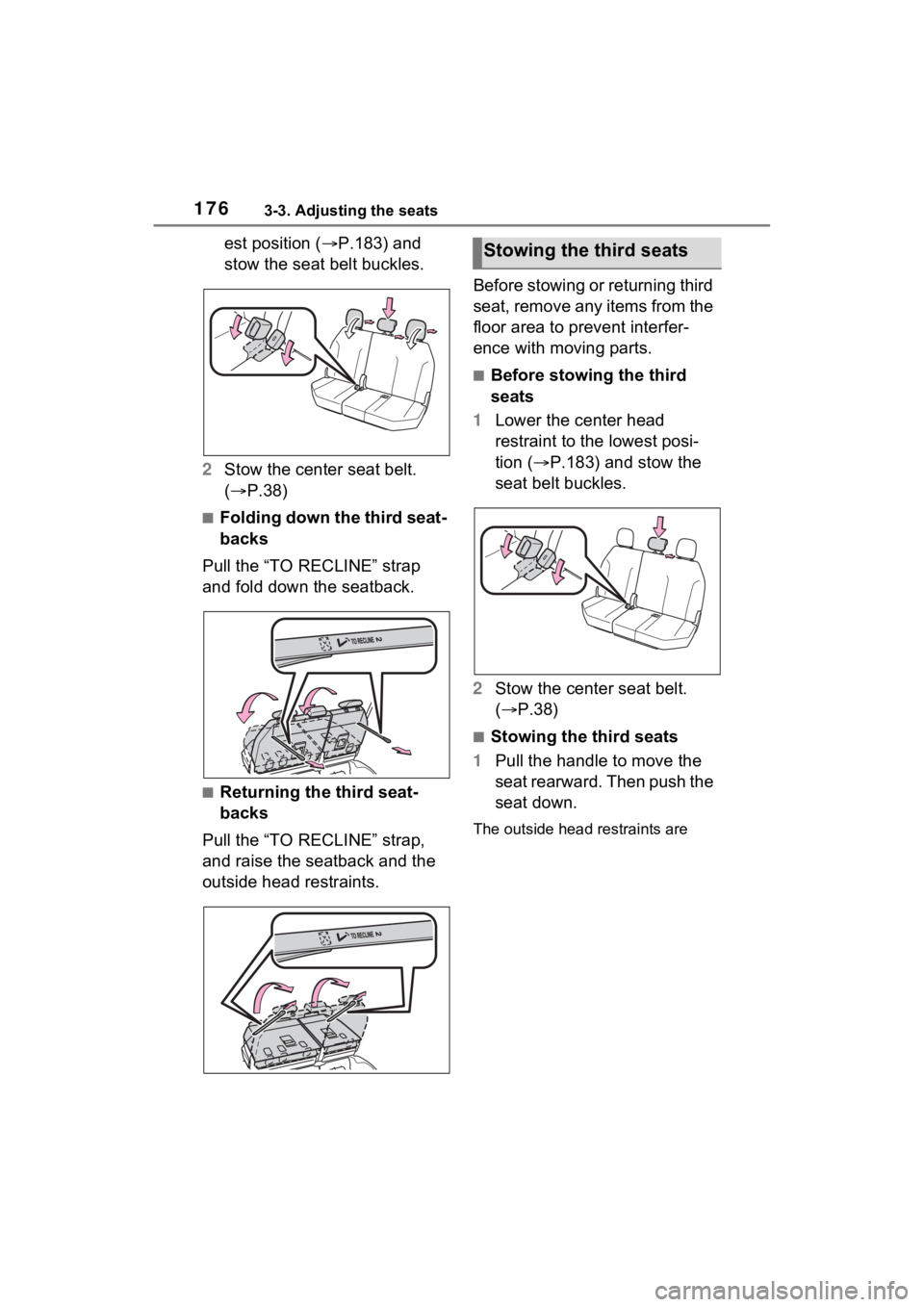
1763-3. Adjusting the seats
est position (P.183) and
stow the seat belt buckles.
2 Stow the center seat belt.
( P.38)
■Folding down the third seat-
backs
Pull the “TO RECLINE” strap
and fold down the seatback.
■Returning the third seat-
backs
Pull the “TO RECLINE” strap,
and raise the seatback and the
outside head restraints. Before stowing or returning third
seat, remove any items from the
floor area to prevent interfer-
ence with moving parts.
■Before stowing the third
seats
1 Lower the center head
restraint to the lowest posi-
tion ( P.183) and stow the
seat belt buckles.
2 Stow the center seat belt.
( P.38)
■Stowing the third seats
1 Pull the handle to move the
seat rearward. Then push the
seat down.
The outside head r estraints are
Stowing the third seats